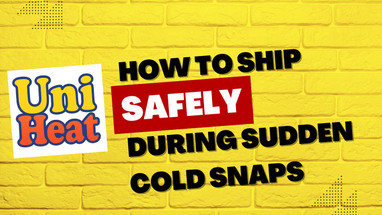Posted by UniHeatPacks on 13th Oct 2025
How to Ship Safely During Sudden Cold Snaps
When temperatures plunge without warning, a normal shipment can become risky for live animals, aquatic corals, plants, feeders, and other temperature-sensitive goods. This guide gives you a practical, step-by-step plan to protect your shipments during cold snaps using insulation, correct heat-pack selection, and airflow management. If you need reliable heat sources in multiple durations, explore UniHeat shipping warmers (40hr, 72hr, 96hr).
1) Make a Fast Weather & Route Plan
- Check the full route, not just origin/destination: Look at the carrier’s hub cities where boxes stage overnight.
- Use absolute temps, not “feels like”: If any leg is forecast below ~32°F (0°C), plan heat; below ~20°F (-6°C), upgrade insulation and consider longer-duration packs.
- Choose the fastest viable service: Overnight is ideal during cold snaps; avoid weekend holds where boxes may sit in unheated depots.
- Ship earlier in the week: Aim Mon–Wed to reduce risk of weather delays rolling into weekends.
2) Build a Cold-Snap Packing System (Insulation + Airflow + Heat)
Great outcomes come from the combination of insulation, controlled airflow, and the right heat output—not from the heat pack alone.
- Insulated liner or cooler: Use a foam cooler or insulated liner inside a sturdy outer box. Fill voids so contents can’t shift.
- Ventilation matters: Heat packs need oxygen. Puncture 2–4 small vents in the outer box (not the inner cooler). Avoid fully airtight setups.
- Thermal layering: Place warmers outside inner specimen bags/containers, separated by cardboard or padding to prevent direct contact.
- Moisture control: Keep packs dry. Use poly bags or kraft to isolate any condensation/gel packs from the warmer.
3) Select the Right UniHeat Duration for Conditions
Match duration to transit time, ambient lows, insulation quality, and box volume. In very cold snaps, step up duration or quantity.
- 40 Hour Small Pet/General Warmer: Short, fast routes with mild-to-moderate overnight lows. View 40hr
- 72 Hour Jumbo Warmer: Standard choice for 1–2 day shipping during typical winter patterns. View 72hr
- 96 Hour Mega Warmer: For severe cold snaps, multi-day routes, or extra insulation headroom. View 96hr
Quick rule of thumb: For an insulated 10–20L shipper in sub-freezing weather, start with one 72hr or 96hr pack; in larger volumes or sub-20°F conditions, use two (separated, not stacked) and increase ventilation slightly.
Pro Tip: “Pre-warm” the shipper’s air space. Activate the warmer(s) 20–30 minutes before sealing so they’re producing steady heat. Keep them dry and exposed to room air during activation.
4) Step-By-Step: Packing for a Cold Snap
- Step 1 – Prepare the box: Assemble the insulated liner or foam cooler inside a rigid outer carton. Add absorbent and void fill.
- Step 2 – Activate warmer(s): Remove from wrapper, gently shake, and let breathe 20–30 minutes. Do not place directly against live animals or specimens.
- Step 3 – Layering: Place a cardboard spacer on the cooler lid interior. Tape the active warmer(s) to the spacer. Add a second thin spacer if needed to prevent hot spots.
- Step 4 – Load contents: Bag live items securely (double-bag aquatic shipments), use cup/lid locks for feeders, and keep all containers upright. Add paper fill to stop movement.
- Step 5 – Ventilate the outer carton: Punch 2–4 pencil-size holes near the top edges of the outer box. Do not vent the inner cooler.
- Step 6 – Seal, label, and ship: Mark “Temperature Sensitive – Protect From Cold.” Drop off as close to carrier cutoff as possible for same-day movement.
5) Troubleshooting & Adjustments in Extreme Cold
- Ship delayed? Add a second warmer and extra kraft fill, or upgrade to a longer duration. Re-check vents (too few → cooler starves pack; too many → heat loss).
- Contents arrived cool but fine: You’re close—slightly increase duration or add a thin insulating layer (bubble, foam sheet) between warmer and contents.
- Over-warm risk: Increase the spacer thickness and reduce the number of vents. Never place a warmer directly on specimen bags or containers.
Frequently Asked Questions
How many heat packs should I use during a cold snap?
For a typical insulated 10–20L shipper in sub-freezing weather, start with one 72hr or 96hr pack. For larger boxes, multi-day routes, or sub-20°F lows, use two warmers on opposite sides with spacers and add a bit more outer-box ventilation.
Can I combine heat packs with cold gel packs?
Generally no—opposing thermal sources fight each other and reduce efficiency. In edge cases (e.g., tropical fish with narrow ranges), isolate gel packs far from the warmer and use robust spacers so the two zones don’t interact directly.
Why is airflow so important?
UniHeat warmers are oxidation-based and need oxygen to generate heat. Airtight setups can starve warmers; too many vents waste heat. Pencil-size holes in the outer carton typically provide the balance needed.
About UniHeat: UniHeat is the original multi-purpose shipping warmer trusted by pet stores, coral farms, breeders, and specialty shippers worldwide. Shop the full range (40hr, 72hr, 96hr) at UniHeat.us.

